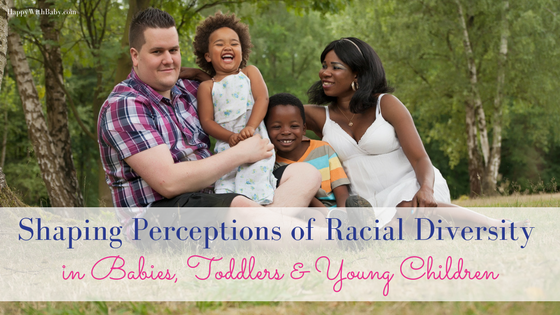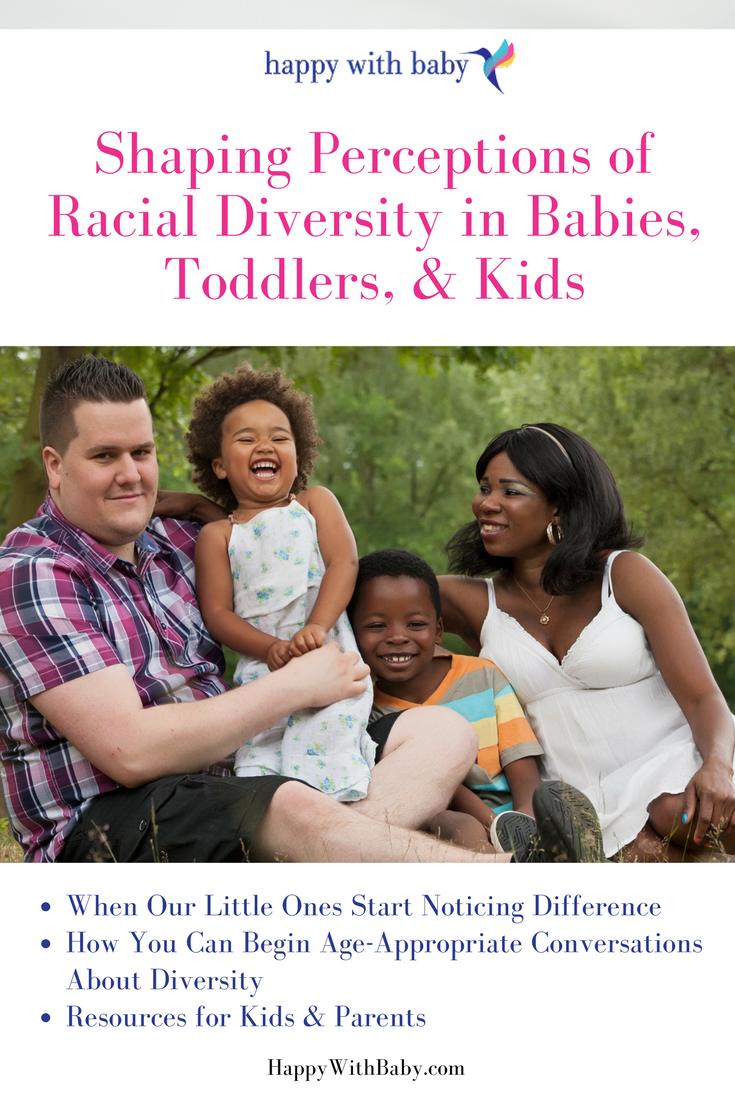Shaping Perceptions of Racial Diversity in Babies, Toddlers & Young Children

Quick--If you had to guess, when do you think our children first begin to notice racial differences?
You might guess that it begins in grade school, when kids are under more pressure to fit in or have had more time to absorb their parents’ perceptions and commentary on different races. But, you’d be wrong. These concepts begin taking shape much, much earlier than that.
The truth is, these perceptions begin to form in infancy. Our babies and children are constantly taking mental notes based on the information we give them.
Last week on the blog, I wrote about separation anxiety and stranger danger, which is a completely normal phase that most babies and toddlers go through regardless of racial differences.
However, while writing it, it also occurred to me just how powerful this phase in child development can be for teaching our children what we want them to know about relationships and community.
During this time in particular, it becomes clearer that our little ones are noticing differences in faces and bodies. And since the door for this discussion is now opened--and given the social events of the last few weeks in Charlottesville and elsewhere--it seems like a good idea to start discussing race and difference as parents and how to handle this topic with our children sooner than later.
Have you ever witnessed your baby crumbling at the sight of someone who looks very different from you or your partner? Obviously, your baby isn’t racist. It’s simply a matter of them being in a situation where they are confronted with something new and unfamiliar, and that might seem frightening to them. (You can read more about “stranger danger” in my previous post.)
Now, imagine this: Let’s say you are walking down the sidewalk in a less familiar part of town and you see someone you don’t know walking up the sidewalk in your direction and you feel a bit nervous. In your conscious mind, you might not be thinking anything in particular, but your subconscious mind tells you to hug your baby to you just a little bit tighter. Baby sees this person too and feels your heartbeat speed up a bit. Your baby’s brain is recording all of these cues, all of which communicate that this situation is not safe regardless of whether safety is an issue in actuality or not.

We can’t assume that our children will grow up “colorblind” because racial colorblindness isn’t actually a thing. Our children will absorb messages from us, but they’ll also receive messages from the outside world--and that part will be out of our control.
Studies show that white children begin showing preference for other white children (like at the playground or at daycare) as early as age 3.
So it is up to us to have those conversations as well as provide positive exposure to those who look different from us to counter the negative, stereotypical or incorrect information they’re receiving. And this can start when they’re very young.
You might be thinking, how in the world do I even do this? I have some ideas.
Here are some ways you can begin to approach the topic of diversity with your children:
-
First off, know that you'll do it imperfectly. And that's OK. It's a complicated topic, so first and foremost, practice some self-empathy and remember that you can always go back and revisit a conversation again later if you feel you made a mistake. This isn't a one-and-done kind of thing.
-
Begin by being curious about the messaging you’ve received over the course of your life about race. What kind of messages did you receive from your parents? What kinds of messages did you receive from school? What about your workplace? What about from society or the news? This is not intended to induce guilt or shame. This is just a practice to be curious about where the messages you’ve received (whether you buy into them or not) have come from.
-
Try to bring some awareness to how you engage with those who are different from you in your life. Just be an observer to your feelings and behaviors and stay curious about those too. Because these are the messages your child will pick up from you.
-
Know that when your child asks questions about someone’s difference (like, “Why does Sadie have two mommies?” or “Why is that man asleep on the sidewalk?” or “Why is grandpa fat?”) that they are innocently curious. This is an invitation to have a conversation with them about how others might be different from us and why the difference is OK. This is also an opportunity to clarify that differences are just that--different--and one way isn’t necessarily better than the other.
-
Find age-appropriate books and media for your little one that features diversity in their characters in positive ways. (I've started a list of resources at the end of this post.)
-
It’s good to understand that young children are very literal. They might look at all the colors in their crayon box and say something like “I’m not black, I’m brown.” or “I’m not white, I’m pink.”
-
Conversely, your child might say something about playing with “the black girl” at school, but don’t panic just yet--your child might just be referring to the girl with black hair, and not her race at all.
-
If your toddler or preschooler makes a comment or observation about someone, approach it with open-ended curiosity to uncover what they’re really thinking or feeling. Ask questions like “Can you tell me more about that?” or “What makes you say that?” or “What did you think about ________?” This can also provide you an opportunity to share your thoughts in a similar way: “I felt _______ when ________ happened.” You can often use TV shows, movies or story books to open up these conversations too.
-
When in doubt, never deny differences when talking to your child. Always be honest and direct, without shaming them. If your child talks about the brown lady next to you, you don’t need to shush them or feel embarrassed. Remember that small children are very literal, so while your child may be commenting on a person’s skin, that doesn’t mean they’re talking about race. You can acknowledge that the woman looks different and also acknowledge that differences are what make us special.
-
Keep it simple. You don’t need to overwhelm them with too much information. This isn’t a one-time conversation--it’s something that will continue to come up over the course of their lives. You’ve got plenty of time to teach them what you want them to know and also how to approach it.
-
Do your best to expose them to different people and places over the course of their lives. Your white child might innocently show preference for other white children at age 3 because it is what's familiar, but without intentional discussion and exposure, this could evolve into prejudice as they grow older.
-
Be reassuring. Sometimes kids just need to know that it is OK to be different, especially if they are a minority.
I know this can feel daunting or scary as a parent and you might be afraid to make a mistake. (In fact, it was scary for me to even find the right words to write this post!) It's OK.
Even our mistakes provide opportunities for us to be conversational and transparent with our kids as they grow. When they see us admitting we are challenged and trying to do better, it gives them permission to do the same.
Some Good Resources and Conversation Openers to Use with Your Kids:
Sesame Street (TV show)
Home (movie)
Zootopia (movie)
Last Stop on Market Street by Matt De La Pena
Thunder Boy Jr. by Sherman Alexie
The Great Big Book of Families by Mary Hoffman
Horton Hears a Who by Dr. Seuss
The Sneetches by Dr. Seuss
Peter’s Chair by Ezra Jack Keats
The Snowy Day by Ezra Jack Keats
The Color of Us by Karen Katz
Green is a Chile Pepper: A Book of Colors by Roseanne Greenfield Thong and John Parra
HeroicGirls.com - An organization dedicated to empowering girls by advocating for strong role models in alternative media
http://multiculturalkidblogs.com/2015/01/16/25-resources-teaching-kids-diversity/
http://www.pbs.org/kcts/preciouschildren/diversity/
What resources would you add to this list? Leave yours in the comments.
Subscribe
Sign up to get the latest weekly blogs sent straight to your inbox


0 comments
Leave a comment
Please log in or register to post a comment